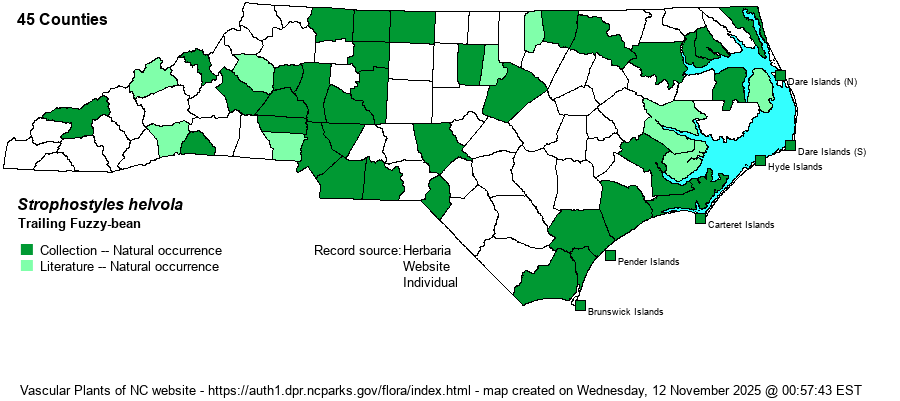| Author | (L.) Elliott | |
| Distribution | Best known as a coastal species, with a scattered range farther west across the interior Coastal Plain and Piedmont; only one known county in the Mountains (Swain).
This is a very widespread species of the central and eastern U.S. and southeastern Canada. It ranges south to northern FL and west to central TX. It is oddly scarce in much of the eastern states, especially in the Appalachians, as compared with the Great Plains states. | |
| Abundance | Common along the coast and in various dry coastal habitats. Farther inland mostly rare to uncommon, being most numerous (infrequent to locally fairly common) in the west-central Piedmont, for some unknown reason. Very rare in the Mountains. | |
| Habitat | The favored habitats of the species are coastal sandy openings, especially on upper beaches and in dunes. Farther from the ocean, it grows in dry or sandy openings, woodland borders, and various other disturbed areas. However, considering these common habitats, it is surprisingly scarce inward from coastal regions. | |
| Phenology | Blooms from June to September, and fruits from August to October. | |
| Identification | This species and S. umbellata are quite similar, both being scattered across the state and both generally similar in appearance. Each is a slender trailing or weakly twining vine, reaching to 3-5 feet long. Each has trifoliate leaves; in this species the 3 leaflets are ovate and about 1.5-2 inches long and nearly as wide, but in this species there are usually two rounded side lobes, often only weakly developed. S. umbellata has un-lobed leaflets. Each has scattered clusters of just a few flowers in each, on very long and often erect stalks that reach 6-10 inches long, well beyond the leaves. The flower is usually bright rose to purple-rose, but can be pink to even whitish, about 1/2-inch across, with the standard upright and quite rounded, that gives each flower a circular shape. There are some characters in the bracts (bracteoles) of each species, but the main differences between the two are the leaflet shape -- mainly tri-lobed in S. helvola, which makes the leaflets wider, especially the terminal leaflet (which is more than 1 inch wide), versus an un-lobed set of leaflets and a narrower terminal leaflet (mostly 3/4-inch wide) in S. umbellata. For those who may be interested, S. helvola is an annual and S. umbellata is a perennial species. You won't have much trouble finding S. helvola along the coast, but finding it inland may be difficult, with much more likely chance of seeing it in the western Piedmont. Note that there are quite a few trailing legumes with 3 leaflets; the two Strophostyles leaflets tend to be larger than many (like Galactia) or a shinier and darker green (looking almost evergreen) than most others. Some observers may have to see flowers or fruit to be sure they are looking at a member of this genus. | |
| Taxonomic Comments | None
| |
| Other Common Name(s) | Annual Sand-bean, Amberique Bean, Beach Pea, Trailing Wild-bean. The two members of the genus have long had numerous common names, none firmly dominant over others. Many use "xxxxx Wild-bean", but that is rather generic, as many other species in this huge family are called some type of Wild-bean. | |
| State Rank | S4 | |
| Global Rank | G5 | |
| State Status | | |
| US Status | | |
| USACE-agcp | FAC link |
| USACE-emp | FACU link |

